Your browser does not fully support modern features. Please upgrade for a smoother experience.
Please note this is an old version of this entry, which may differ significantly from the current revision.
The genus Malachra L. belongs to the family Malvaceae. It includes herbs or subshrubs of nine accepted species with approximately thirty synonyms, and it has been widely used in community folk medicine to treat health problems including inflammation, nasal obstruction, leishmaniasis, malaria, childbirth, kidney disorders, fever, respiratory tract diseases, among others.
- Malachra
- ethnobotany
- pharmacological activity
1. Botanical Description of the Species of the Genus Malachra L.
The genus Malachra L. is represented by herbs or suffrutes, sometimes puberulent, generally hispid, or with stinging trichomes. Leaves are simple or palmately lobed; acute, acuminate, or obtuse at the apex; truncated or subcordate at the base; serrated or crenated; and generally pubescent. They also present: bracteate inflorescences; axillary or terminal heads; broadly cordate-ovate bracts at the base, with prominent nerves often alternating with whitish areas, although it can be in other parts green and sessile. Absent calliculus (except in M. radiata); small calyx, five-lobed; white, yellow, or lilac corolla; and five-lobed leaves can also be observed. Additionally, schizocarpal fruits have the shape of a wheel similar to a cheese that can be split into five ripe wing types; flowers are in heads, surrounded by bracts larger than them [ 17 , 41 , 42 , 43 ].
Malachra alceifolia Jacq. is a herb or shrub, 1. 6 m tall. The aerial parts and petioles are hispid, simple or split, flavescent, tuberculate base, scattered hairs, short, star-shaped, and long forming knots, with stem pubescence and a green to reddish color. The leaves are simple, opposite, and lobed, with up to five lobes, with pubescence, and their margins are serrated or toothed. There are inflorescences in axillary heads with the presence of acuminate bracts and flowers with five petals, 2 to 3 cm in diameter, with a yellow coloration. The fruits have bracts and persistent calyx, with numerous seeds, up to 2 mm in diameter, dark colored, and flattened ( Figure 1 ) [ 44 ].
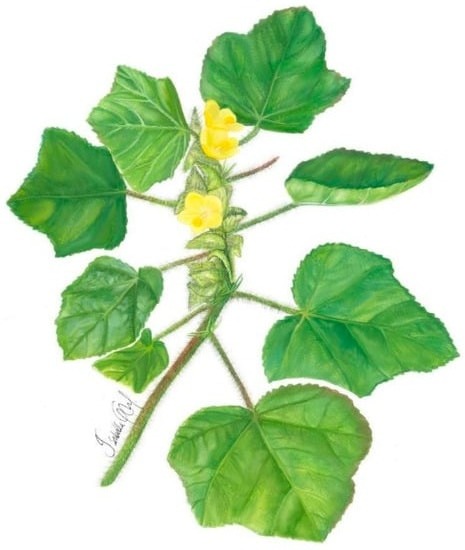
Figure 1. Malachra alceifolia Jacq.
Malachra capitata Linn. is a herb or subshrub, up to 2 m tall, with stem pubescence and green to orange coloration. The leaves are simple, opposite, palmate or lobed, with up to five lobes; the texture of the leaves is velvety and their margins are crenulate or serrated. Inflorescences are peduncular and axillary, with the presence of lanceolate bracts; flowers have five petals, 1 cm in diameter, with a white coloration. Schizocarpic fruits have single seeds up to 3 mm in diameter, and are dark colored ( Figure 2 ) [ 45 ].
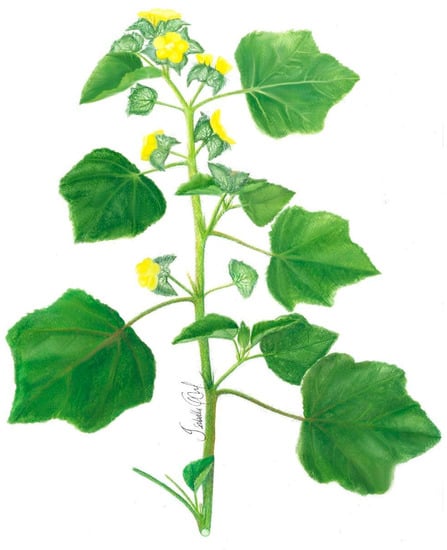
Figure 2. Malachra capitata Linn.
Malachra fasciata Jacq. is a herb or subshrub, up to 2 m tall, with stem pubescence, simple or stellate trichomes up to 7 mm, and green to orange coloration. The leaves are simple, opposite, ovate, truncated at the base, acute at the apex, lobed or deeply parted, otherwise crenate-serrate, pubescent above with appressed trichomes. The heads are short-stalked bracts, 2–6 per head, lance/ovate, subcordate at the base, acute at the apex, often ciliate, prominently hispid. Calyx 4 to 5 mm, hispid; petals white 6–8 mm, mericarps light brown to grayish green, reticulate veined (Figure 3) [1].
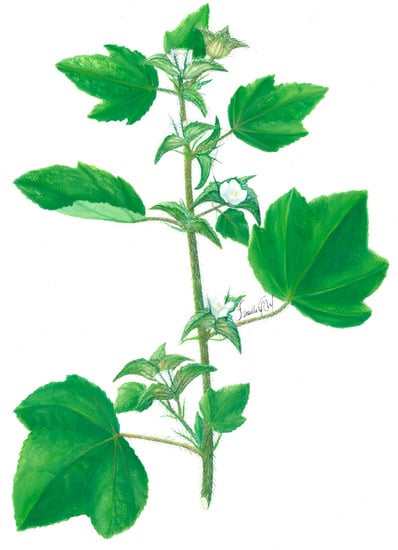
Figure 3. Malachra fasciata Jacq.
Malachra radiata (L.) L. is a herb or suffrutex, 1.5 m tall, with stem pubescence and green and purple coloration. The leaves are simple, opposite, palmate or lobed, with up to seven lobes; the texture of the leaves is velvety, and their margins are crenulate or serrated, and most apical leaves may have a triangular shape. Inflorescences are pedicular and terminal, with the presence of ovate or acute bracts; flowers have five petals, 2.5 cm in diameter, with a lilac coloration and purple at the base. Schizocarpic fruits have numerous seeds, up to 2 mm in diameter, and are dark colored (Figure 4) [2].
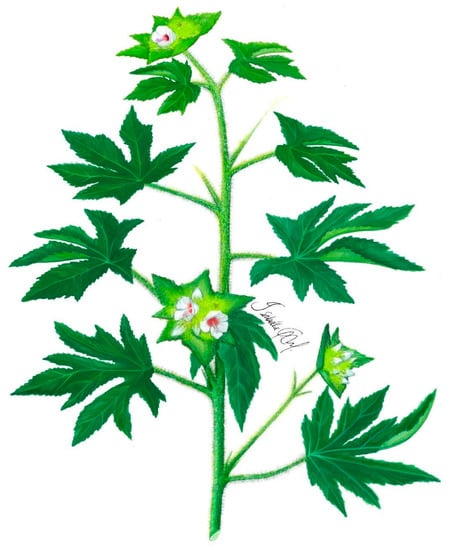
Figure 4. Malachra radiata (L.) L.
Malachra ruderalis Gürke. is an annual herb, up to 3 m high, with stem pubescence and green coloration. The leaves are simple, opposite, palmate or lobed, with up to five lobes; the texture of the leaves is velvety, and their margins are crenulate; the most apical leaves have a triangular shape. It shows pedicular inflorescence with terminal or acute axillary bracts, five petals, 3 cm long, with yellow schizocarpic fruit with numerous dark-colored seeds up to 2 mm in diameter (Figure 5) [3][4].
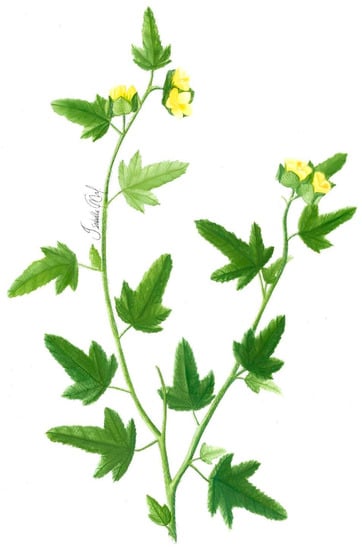
Figure 5. Malachra ruderalis Gürke.
Malachra rudis Benth. is a perennial herb, up to 0.7 m high, with a stem that has very short pubescence, and its coloration is light green. The leaves are simple, opposite, lobed, with up to three lobes; velvety texture; crenulated margins with pedicular, axillary, or terminal inflorescence; ovate bracts with five petals; 1.5 cm in long. Schizocarpic fruits are yellow to white with numerous seeds up to 1 mm in diameter, one per carpel (Figure 6) [3][4].
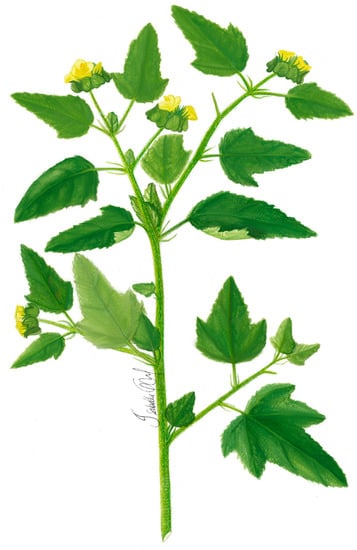
Figure 6. Malachra rudis Benth.
Malachra urens Poit. ex Ledeb. & Alderstam is an annual herb, up to 1 m high, with pubescent stems of different sizes and green to orange coloration. The leaves are simple, opposite and lobed, with up to three lobes relatively marked, with pubescence; the margins of the leaves are toothed, about 3–12 cm long. Inflorescences are peduncular racemes with acuminate, boat-shaped, pubescent bracts. Flowers have five petals, 2 to 3 cm in long, with a yellow color. Schizocarpic fruits have mericarps and pubescent bracts, with numerous seeds, up to 2 mm in long, dark colored, and flat (Figure 7) [3][4].
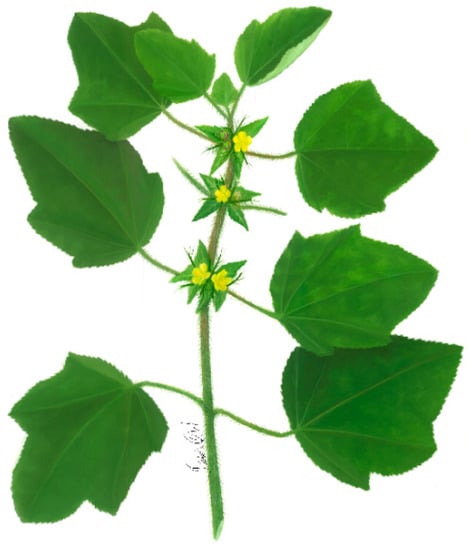
Figure 7. Malachra urens Poit.
Malachra helodes Mart. is an annual herb, up to 1 m high. The stem is slightly pubescent with dark to light green coloration. The leaves are simple, opposite, and lobed, with up to five lobes that are well marked, with slightly marked pubescence on the underside; the margins of the leaves are serrated, about 3–10 cm long. Inflorescences are terminal and axillary racemes with the presence of acuminate bracts in the form of pubescent. The flowers have five petals, 2 to 3 cm in length, with a pink color. Schizocarpic fruits with mericarps and bracts with stem indumentum hispid; terminal inflorescence; pinkish flower; epicalyx absent; fruit, up to 4 mm in length; glabrous indumentum (Figure 8) [3][4].
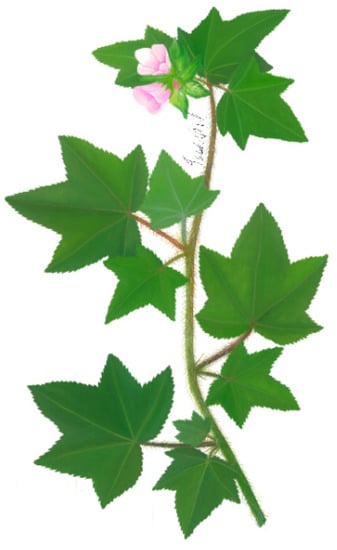
Figure 8. Malachra helodes Mart. ex Ledeb. & Alderstam.
2. Phytochemistry Species of the Genus Malachra L.
Phytoconstituents are chemical compounds that plants synthesize as a defense mechanism against biotic and abiotic environmental conditions; they play key roles in biological processes [5][6]. Many phytoconstituents isolated from the genus Malachra L., such as flavonoids, coumarins, carbohydrates, glycosides, triterpenes, alkaloids, tannins, and saponins, exhibit pharmacologic activity. Table 1 lists the phytoconstituents reported only in Malachra species: M. alceifolia Jacq., M. capitata (L.) L., and M. fasciata Jacq, see Figure 9 molecular structure of some compounds isolated from species of the genus Malachra L.
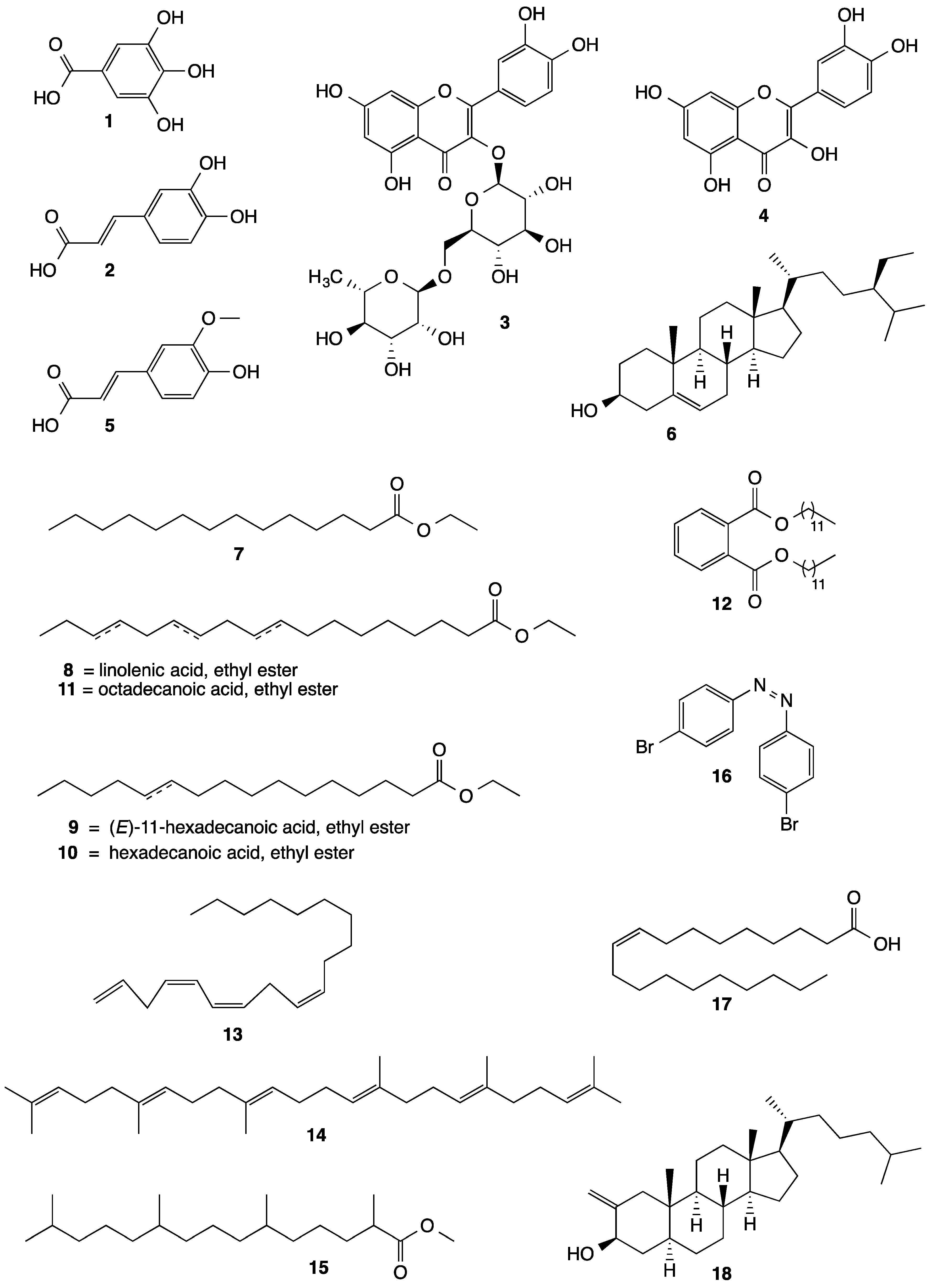
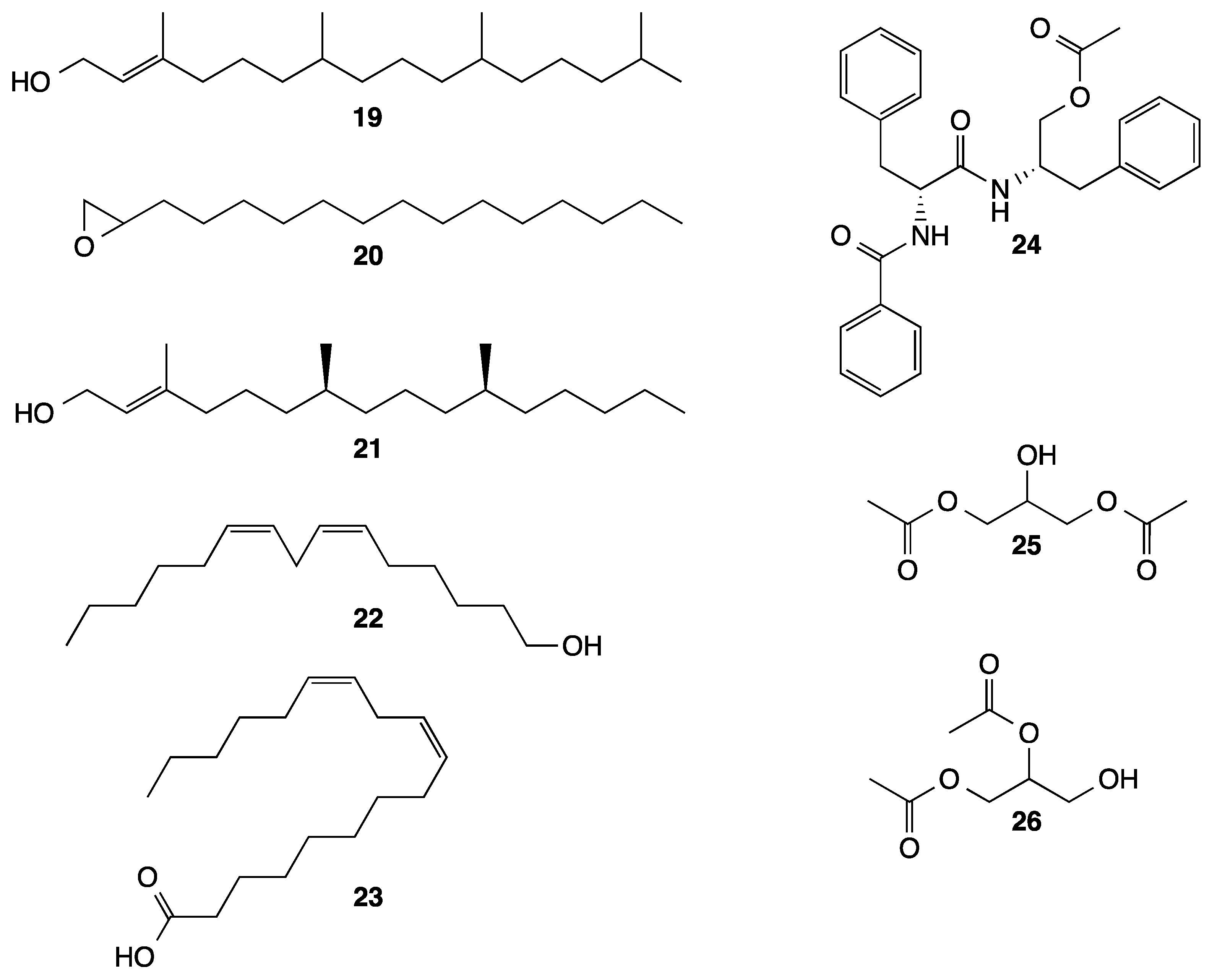
Figure 9. Molecular structure of some compounds isolated from species of the genus Malachra L.
Table 1. Major phytoconstituents identified in species of the genus Malachra L.
| Malachra species | Plant Part Used | Phytoconstituents | Reference |
|---|---|---|---|
| Malachra alceifolia Jacq. | Leaf | Flavonoids, steroids, triterpenes anthocyanins, leucoanthocyanins, saponins |
[7] |
| Flowers | Flavonoids, steroids, triterpenes anthocyanins, leucoanthocyanins |
||
| Malachra capitata (L.) L. | Root | Gallic acid (1), caffeic acid (2), rutin (3), quercetin (4), ferulic acid (5) | [8][9] |
| Leaf | Rutin, ferulic acid | ||
| Stem | Gallic acid | ||
| Whole plant | β-Sitosterol (6) | [10] | |
| Root | Carbohydrates, phenols, flavonoids, glycosides, triterpenes, alkaloids, tannins, saponins | [8][9] | |
| Root | Tetradecanoic acid, ethyl ester (7); | [8][9] | |
| linolenic acid, ethyl ester (8); | |||
| (E)-11-hexadecenoic acid, ethyl ester (9); | |||
| hexadecanoic acid, ethyl ester (10); | |||
| octadecanoic acid, ethyl ester (11); | |||
| didecyl phthalate (12); | |||
| (Z,Z,Z)-1,4,6,9-nonadecatetraene (13); | |||
| squalene (14) | |||
| Stem | Tetradecanoic acid, ethyl ester; | [11][12] | |
| pentadecanoic acid, 2,6,10,14- tetramethyl methyl ester (15); |
|||
| linolenic acid, methyl ester; | |||
| (E)-11-hexadecenoic acid, ethyl ester; | |||
| octadecanoic acid, ethyl ester; | |||
| (Z,Z,Z)-1,4,6,9-nonadecatetraene | |||
| azobenzene, 4,4′-dibromo- (16); | |||
| squalene | |||
| oleic acid (17) | |||
| Cholestan-3-ol, 2-methylene-(3β,5α)- (18); | |||
| Leaf | Tetradecanoic acid, ethyl ester | [11][12] | |
| 3,7,11,15-tetramethyl-2-hexadecen-1-ol (19); | |||
| Oxirane, tetradecyl- (20); | |||
| (E)-11-hexadecenoic acid, ethyl ester | |||
| Hexadecanoic acid, ethyl ester | |||
| Phytol (21); | |||
| (Z,Z) 6,9 pentadecadien-1-ol (22); | |||
| (Z,Z) 9,12-octadecadienoic acid (23); | |||
| octadecanoic acid, ethyl ester; | |||
| squalene | |||
| Leaf | Flavonoids, glycosides, triterpenes, alkaloids, tannins, saponins, phlobatannins | [11][12] | |
| Malachra fasciata Jacq. | Leaf | Aurantiamide acetate (24) | [13] |
| Leaf | 1,3-Diacylglycerol (25) 1,2-Diacylglycerol (26) |
[14] |
Generally, organic compounds obtained from extracts, fractions, and isolated compounds of plant species possess unique structural characteristics among which the geometrical and energetic interactions of the atoms stand out; chirality and stereoisomers of molecular structures, intermolecular interactions, hydrogen bond acceptors and donors, molecular mass, diversity of ring systems, among others, become tools of interest for medicinal chemistry in drug development, to improve the potency, for pharmacokinetic properties, and to reduce the toxicity of new drugs [15]. However, the secondary metabolites isolated from plant species constitute a group of chemical molecules with a great diversity of biological activities applied to the pharmaceutical, cosmetic, and food sectors [16].
Gallic acid (GA) is a phenolic compound with anti-inflammatory, antimicrobial, hepatoprotective, neuroprotective, and carcinogenic properties that prevent gastrointestinal, cardiovascular, metabolic, and neuropsychological diseases [17]. The livers of Wistar rats exposed to carbon tetrachloride in doses of 50 mg/kg and 100 mg/kg GA, were evaluated by decreasing serum liver enzymes, regulating the expression of proinflammatory genes, and regulating the expression of antioxidant genes [18]; mercuric chloride induced at 200 mg/kg, increased glutathione peroxidase, superoxide dismutase, and catalase activity, and decreased the level of glutathione in liver tissue [19]. Caffeic acid has antimicrobial potential against Staphylococcus aureus strains with MICs from 256 µg/mL to 1024 µg/mL [20]. The compound quercetin isolated from extracts and organic fractions of Allium cepa L., Morus alba, Camellia sinensis, Moringa oleifera, and Centella asiatica, at doses between 50 and 100 mg/kg, and evaluated in in vivo models, showed antiulcer activity [21]. Beta-sitosterol isolated chloroform extract of Corchorus capsularis L. leaves has been shown to exhibit a significant effect against trypanothione reductase Leishmania donovani promastigotes at IC50 = 17.7 ± 0.43 µg/mL [22], and the dipeptide aurantiamide acetate patent has an effect of resisting influenza virus and an inhibition effect on a cytopathic effect mediated by the influenza A virus CN106431960B, filing date: 11 November 2018, legal status: active [23].
3. Species of the Genus Malachra L. with Pharmacological Activity
Applications of plant remedies in traditional medicine are still central in the health systems in some countries of world [24]. The biogenesis and biosynthesis of phytoconstituents in plant species provide an opportunity for medicinal chemistry to advance pharmacological studies for treating pathologies that have been little studied [25]. Table 2 summarizes the most important pharmacological activities reported for the genus Malachra L., such as antidiarrheal, anti-epileptic, antiulcerogenic, antioxidant, anticonvulsant, hepatoprotective, antiviral, anticancer, antibacterial, and anthelmintic properties. The bibliographic search describes only the pharmacological activities of M. alceifolia Jacq., M. capitata (L.) L., and M. fasciata Jacq.
Table 2. Summary of the species of the genus Malachra L. with reported pharmacological activity.
| Malachra Species | Plant Part Used | Extract/Compounds | Pharmacological Activity | Concentration | Method | Major Findings | Reference |
|---|---|---|---|---|---|---|---|
| M. alceifolia Jacq. | Leaf | Ethanolic | Antiplasmodial | 10 µg/mL | In vitro Plasmodium falciparum 152.2 ± 28.6 nM Chloroquine control |
Inhibitory activity on P. falciparum ferriprotoporphyrin biomineralization inhibition |
[26][27] |
| Shoot | Ethanolic | Antiplasmodial | 77 µg/mL | In vitro Plasmodium falciparum (3D7) chloroquine (concentration no report) |
Inhibitory activity on P. falciparum |
[28] | |
| M. capitata (L.) L. |
Leaf | Ethanolic | Antibacterial | 62.5 ppm | In vitro MIC |
Inhibition of the growth of Propionibacterium acnes (ATCC 6919) |
[29] |
| Shoot | Aqueous | Antidiarrhoeal | 200 and 400 mg/kg | In vivo oral administration to Wistar rats; castor oil-induced diarrhoea, enteropooling, and small intestinal transit; 5 mL/kg, p.o diphenoxlate control |
Decreases intestinal transit | [30] | |
| Aqueous | Anti-epileptic | 250 and 500 mg/kg | In vivo maximal electroshock (MES) and pentylenetetrazole (PTZ)-induced seizuresmodels in albino Wistar rats, pentylenetetrazol control |
Anticonvulsant activity against MES and PTZ animal models | [30] | ||
| Aqueous | Anti-ulcerogenic | 200 mg/kg y 400 mg/kg | In vivo oral administration to Wistar rats pylorus ligated model, 50mg/kg, p.o ranitidine control |
Reduce the gastric acid secretion of pylorus |
[ 72 ] | ||
| Aqueous | Antioxidant | 200 y 400 mg/kg | In vivo oral administration to Wistar rats |
In vivo oral administration to Wistar rats pylorus ligated model, 50mg/kg, p.o ranitidine control |
[ 73 ] | ||
| Aqueous | Hepatoprotective | 100, 200 y 400 mg/kg | In vivo oral administration to Wistar rats, carbon tetrachloride CCl4 induced hepatotoxicity |
Reduced levels of the hepatic enzymes SGOT, SGPT, alkaline phosphatase (ALP), and acid phosphatase (ACP) |
[ 74 ] | ||
| Leaf silver nanoparticles (AgNPs) |
n-hexane | Antibacterial | 1 mM | In vitro MIC |
Nanoparticles bactericidal Bacillus subtillis, Micrococcus Luteus, Staphylococcus aureus and Pseudomonas aeruginosa |
[ 75 ] | |
| Leaf | Methanolic, Chloroform Benzene |
Antibacterial | 50 mg/mL | In vitro MIC |
Inhibition of the growth of Escherichia coli, Listeria monocytogenes |
[ 76 ] | |
| Malachra fasciata Jacq. | Leaf | Chloroform/ Aurantiamide acetate |
Antibacterial | 80 µg | In vitro MIC |
Inhibition of the growth of P. aeruginosa, B. subtilis, C. albicans |
[ 29 ] |
| Leaf | Unknown | Phototoxic (photosensitization) |
Unknown | In vivo sheep females and male |
Cause of primary photodermatitis in sheep ingestion leaf |
[ 77 ] | |
| Leaf | Chloroform | Antifungal | 30 µg | In vitro MIC |
Inhibition of the growth of Aspergillus niger |
[ 29 ] | |
| Leaf | -(-)loliolide | Antimutagenic | 8 mg/kg | In vitro micronucleus test induced using mitomycin C, 32% |
Reduce the number of micronucleated polychromatic erythrocytes (MPCE) |
[ 30 ] |
This entry is adapted from the peer-reviewed paper 10.3390/plants11212808
References
- World Flora Online (WFO). Malachra L. 2022. Available online: http://www.worldfloraonline.org/taxon/wfo-4000022923 (accessed on 21 September 2022).
- Medicinal Plant Names Services (M.P.N.S.). Malachra. 2022. Available online: http://mpns.kew.org/mpns-portal/ (accessed on 11 January 2022).
- Plants of the World Online (P.O.W.O.). Malachra. 2022. Available online: www.plantsoftheworldonline.org (accessed on 11 February 2022).
- Tropicos.org. Missouri Botanical Garden. Available online: http://www.tropicos.org/Name/19601021 (accessed on 1 July 2022).
- World Flora Online. Malachra alceifolia Jacq. 2022. Available online: http://www.worldfloraonline.org/taxon/wfo-0000449783 (accessed on 30 June 2022).
- World Flora Online. Malachra capitata (L.) L. 2022. Available online: http://www.worldfloraonline.org/taxon/wfo-0000449780 (accessed on 1 July 2022).
- World Flora Online. Malachra fasciata Jacq. 2022. Available online: http://www.worldfloraonline.org/taxon/wfo-0000449806 (accessed on 1 July 2022).
- World Flora Online. Malachra radiata (L.) L. 2022. Available online: http://www.worldfloraonline.org/taxon/wfo-0000449849 (accessed on 1 July 2022).
- The Global Biodiversity Information Facility (G.B.I.G.). Malachra. 2022. Available online: www.gbif.org (accessed on 11 February 2022).
- The International Plant Names Index and World Checklist of Vascular Plants 2022. Available online: https://powo.science.kew.org/taxon/urn:lsid:ipni.org:names:25960-1 (accessed on 22 August 2022).
- Abat, J.K.; Kumar, S.; Mohanty, A. Ethnomedicinal, phytochemical and ethnopharmacological aspects of four medicinal plants of Malvaceae used in Indian traditional medicines: A Review. Medicines 2017, 4, 75.
- Varma, N. Phytoconstituents and their mode of extractions: An overview. Res. J. Chem. Environ. Sci. 2016, 4, 8–15. Available online: http://www.aelsindia.com/rjcesapril2016/2.pdf (accessed on 25 August 2022).
- Guerreo, T.; Vejarano, P.; Ochoa, R. Tamizaje fitoquímico y cuantificación de flavonoides totales de las hojas y flores de Malachra alceifolia Jacq. Ethnobot. Res. Appl. 2018, 4, 70–75. Available online: https://revistas.unas.edu.pe/index.php/revia/article/view/73 (accessed on 21 August 2022).
- Sindhu, L.; Neelamegam, R. HPLC determination of flavonoids in the methanol extracts of Malachra capitata (L). WJPPS 2015, 4, 1495–1503. Available online: https://storage.googleapis.com/journaluploads/wjpps/article_issue/1438403289.pdf (accessed on 21 August 2022).
- Sindhu, L.; Neelamegam, R. Evaluation of phytochemical profile in ethanol extracts of Malachra capitata (L.) by GC-MS analysis. World J. Pharm. Res. 2015, 4, 1342–1353.
- Jadhav, R.; Parihar, S. Isolation and Study of β-sitosterol the Unsaponifiable Matter from the Plant Malachra capitata (Linn). Biomed. Pharmacol. J. 2014, 7, 285–287.
- Dipak, K.; Rupali, S.; Syed, I.; Bhadange, D.G. Phytochemical screening of eight traditionally used ethnomedicinal plants from Akola District (M.S.) India. Int. J. Pharma Bio Sci. 2010, 1, 253–256. Available online: https://www.ijpbs.net/abstract.php?article=NDE= (accessed on 30 August 2022).
- Pratyusha, S.; Jayasri, P.; Elumalai, A. Study on phytochemical profile and antiulcerogenic effect of Malachra capitata (L.) in albino Wistar rats. Int. J. Preclin. Pharm. Res. 2012, 3, 97–103. Available online: http://www.preclinicaljournal.com/download.php?id=116&f=116_97-103.pdf (accessed on 30 August 2022).
- Ragasa, C.; Hofileña, J.; Co, A.; Rideout, J. Antifungal diacetylglycerols from Malachra fasciata and Pithecolobium dulce. Chem. Res. 2005, 19, 1–5. Available online: https://acquire.cqu.edu.au/articles/journal_contribution/Antifungal_diacetyglycerols_from_Malachra_fasciata_and_Pithecolobium_dulce/13398602 (accessed on 30 March 2022).
- Ragasa, C.; Peñalosa, B.; Rideout, J.A. A bioactive dipeptide derivate from Malachra fasciata. Philipp. J. Sci. 1998, 127, 267–276. Available online: https://inis.iaea.org/search/search.aspx?orig_q=RN:30051341 (accessed on 30 March 2022).
- Najmi, A.; Javed, S.A.; Al Bratty, M.; Alhazmi, H.A. Modern Approaches in the Discovery and Development of Plant-Based Natural Products and Their Analogues as Potential Therapeutic Agents. Molecules 2022, 27, 349.
- Batiha, G.E.S.; Beshbishy, A.A.; Tayebwa, D.S.; Shaheen, M.H.; Yokoyama, N.; Igarashi, I. Inhibitory effects of Uncaria tomentosa bark, Myrtus communis roots, Origanum vulgare leaves and Cuminum cyminum seeds extracts against the growth of Babesia and Theileria in vitro. Jap. J. Vet. Parasitol. 2018, 17, 1–13.
- Kahkeshani, N.; Farzaei, F.; Fotouhi, M.; Alavi, S.S.; Bahramsoltani, R.; Naseri, R.; Momtaz, S.; Abbasabadi, Z.; Rahimi, R.; Farzaei, M.H.; et al. Pharmacological effects of gallic acid in health and diseases: A mechanistic review. Iran. J. Basic Med. Sci. 2019, 22, 225–237.
- Ojeaburu, S.I.; Oriakhi, K. Hepatoprotective, antioxidant and, anti-inflammatory potentials of gallic acid in carbon tetrachloride-induced hepatic damage in Wistar rats. Toxicol. Rep. 2021, 8, 177–185.
- Goudarzi, M.; Kalantar, M.; Kalantar, H. The Hepatoprotective Effect of Gallic Acid on Mercuric Chloride-Induced Liver Damage in Rats. Jundishapur J. Nat. Pharm. Prod. 2017, 12, e12345.
- Kępa, M.; Miklasińska-Majdanik, M.; Wojtyczka, R.D.; Idzik, D.; Korzeniowski, K.; Smoleń-Dzirba, J.; Wąsik, T.J. Antimicrobial Potential of Caffeic Acid against Staphylococcus aureus Clinical Strains. BioMed Res. Int. 2018, 2018, 7413504.
- Anand David, A.V.; Arulmoli, R.; Parasuraman, S. Overviews of biological importance of quercetin: A bioactive flavonoid. Pharmacogn. Rev. 2016, 10, 84–89.
- Pramanik, P.K.; Chakraborti, S.; Bagchi, A.; Chakraborti, T. Bioassay-based Corchorus capsularis L. leaf-derived β-sitosterol exerts antileishmanial effects against Leishmania donovani by targeting trypanothione reductase. Sci. Rep. 2020, 10, 20440.
- Application and Its Preparation of the Aurantiamide Acetate in Anti-Influenza virus Medicament. Patent CN106431960B, 6 November 2018. Available online: https://patents.google.com/patent/CN106431960B/en (accessed on 25 August 2022).
- Batiha, G.E.; Alkazmi, L.M.; Wasef, L.G.; Beshbishy, A.M.; Nadwa, E.H.; Rashwan, E.K. Syzygium aromaticum L. (Myrtaceae): Traditional Uses, Bioactive Chemical Constituents, Pharmacological and Toxicological Activities. Biomolecules 2020, 10, 202.
- Beshbishy, A.M.; Batiha, G.E.S.; Adeyemi, O.S.; Yokoyama, N.; Igarashi, I. Inhibitory effects of methanolic Olea europaea and acetonic Acacia laeta on the growth of Babesia and Theileria. Asian Pac. J. Trop. Med. 2019, 12, 425–434.
- Kvist, L.; Christensen, S.; Rasmussen, H.; Mejia, K.; Gonzalez, A. Identification and evaluation of Peruvian plants used to treat malaria and leishmaniasis. J. Ethnopharmacol. 2006, 106, 390–402.
- López-Cuesta, B. Studio Ethnobotanics of Plants Against Malaria. 2017. Available online: http://147.96.70.122/web/TFG/TFG/Memoria/Beatriz%20Cuesta%20Lopez.pdf (accessed on 22 March 2022).
- Ruiz, L.; Ruiz, L.; Maco, M.; Cobos, M.; Gutierrez-Choquevilca, A.-L.; Roumy, V. Plants used by native Amazonian groups from the Nanay River (Peru) for the treatment of malaria. J. Ethnopharmacol. 2011, 133, 917–921.
- Salazar-Gómez, L.; Pérez-Coronado, J. Evaluación in vitro Del Efecto Antibacteriano De Los Extractos Etanólicos De Maclura tinctoria Linn, Cassia fistula Linn. Y Malachra alceifolia Jacq, Y Su Contribución a La Formulación De Un Fitoterapéutico Para El Tratamiento Del Acné. 2018. Available online: http://hdl.handle.net/11227/7008 (accessed on 9 September 2021).
- Gopi, G.; Jayasri, P.; Elumalai, A. Anti-epileptic activity of Malachra capitata (L) on maximal electroshock (MES) and Pentylenetetrazole (PTZ) induce seizures models. Int. J. Pharmacol. Toxicol. 2012, 2, 104–108. Available online: http://www.ijidd.com/File_Folder/76-80.pdf (accessed on 22 September 2022).
- Anil-Kumar, V.; Prunachander, K.; Vasudevamurthy, V.; Kannappan, N.; Spandana, V. Anti-oxidante activity of Malachra capitata (L) against Carbon Tetrachloride (CCL4) induce erythrocyte damage in rats. Int. J. Pharmacol. Res. 2012, 2, 74–78.
- Sriam, N.; Vinoth-Kumar, K.; Mantry, S.; Sakthivel, S.; Shiva-Prasad, P. Hepatoprotective effect of Malachra capitata (L) against Carbon Tetrachloride induced hepatotoxicity in wistar albino rats. Int. J. Pharm. Rev. Res. 2012, 2, 106–110. Available online: https://file:///D:/Documents/Downloads/HEPATOPROTECTIVE_EFFECT_OF_MALACHRA_CAPI.pdf (accessed on 22 September 2022).
- Srirangam, G.M.; Rao, P. Synthesis and characterization of silver nanoparticles from the leaf extract of against Malachra capitata. RJC 2017, 10, 46–53.
- Naik, R.M.; Ahmed, S.; Venkatalakshmi, K. Preliminary Phytochemistry and Anti-Microbial Activity of Malachra capitata Plant. Am. J. PharmTech Res. 2018, 8, 258–263. Available online: http://ajptr.com/assets/upload/publish_article/AJPTR-83022_443.pdf (accessed on 22 September 2022).
- De Araújo, V.O.; Neto, T.S.O.; Simões, S.V.D.; da Silva, T.K.F.; Riet-Correa, F.; Lucena, R.B. Primary photosensitization and contact dermatitis caused by Malachra fasciata Jacq. N.V. (Malvaceae) in sheep. Toxicon 2017, 138, 184–187.
This entry is offline, you can click here to edit this entry!
